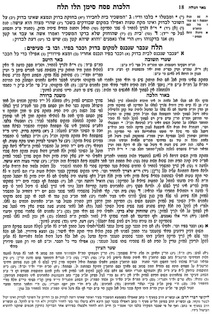Medieval Jewish History
Alanna E. Cooper
Fall 2012
SESSION 10: Legal Codes

READING
On the Mishneh Torah
Book 1, Basic Principles of the Torah, Ch. 1 (p.43-45)
Book 1, Laws Relating to Moral Dispositions, Ch. 1 (p.51-53)
Book 2, Laws of Prayer, Ch. 4 (p.90-91)
Book 3, Sabbath, Ch.24 (p.103-105)
Book 3, Reading of the Megillah and Hannukah, (p.117-119)
Book 5, Forbidden Intercourse, Ch.14 (p.121-122)
Book 7, Gifts to the Poor, Ch.10 (p.135-139)
Book 9, Festal Offerings, Ch.2 & 3 (p.147-149)
Book 11, Theft, p.156-158
Book 14, Sanhedrin, Ch.4 (p.194-195)
On the Shulhan Arukh and the Mishna Brura
On the Mishneh Torah
- Intro to the Mishne Torah, in Twersky’s Maimonides Reader p.35-41
- Excerpts from the Mishne Torah in Twersky’s Maimonides Reader. The excerpts listed below should give you a sense of the work's style and scope:
Book 1, Basic Principles of the Torah, Ch. 1 (p.43-45)
Book 1, Laws Relating to Moral Dispositions, Ch. 1 (p.51-53)
Book 2, Laws of Prayer, Ch. 4 (p.90-91)
Book 3, Sabbath, Ch.24 (p.103-105)
Book 3, Reading of the Megillah and Hannukah, (p.117-119)
Book 5, Forbidden Intercourse, Ch.14 (p.121-122)
Book 7, Gifts to the Poor, Ch.10 (p.135-139)
Book 9, Festal Offerings, Ch.2 & 3 (p.147-149)
Book 11, Theft, p.156-158
Book 14, Sanhedrin, Ch.4 (p.194-195)
On the Shulhan Arukh and the Mishna Brura
- Read article, "The Shulhan Arukh" here
- Excerpts from the Mishna Brura in the course pack (we will read and discuss in class)
NOTES ON READING
In the 21st century there’s a “handbook for dummies” on just about every subject imaginable (Alternative Medicine, Divorce, Camping, T’ai Chi, and so much more….). So, from where we sit, it may be hard to imagine that for much of Jewish history, there was no manual for Judaism. Indeed, until the high Middle Ages, there were no books that outlined in any systematic manner, how Jews should go about practicing their religion.
Then came a new genre of literature: Codes of Law, which outlined Judaism’s basic principles, practices and underlying moral premises. In this session we will discuss the need that these sorts of books filled, the rationale behind them, how they gained legitimacy, as well as how they were organized.
We will look specifically at two works: Mishne Torah and the Shulhan Aruch. And we will also discuss the way in which these two books became part of an ever-expanding library, that continues to have practical relevance today.
In the 21st century there’s a “handbook for dummies” on just about every subject imaginable (Alternative Medicine, Divorce, Camping, T’ai Chi, and so much more….). So, from where we sit, it may be hard to imagine that for much of Jewish history, there was no manual for Judaism. Indeed, until the high Middle Ages, there were no books that outlined in any systematic manner, how Jews should go about practicing their religion.
Then came a new genre of literature: Codes of Law, which outlined Judaism’s basic principles, practices and underlying moral premises. In this session we will discuss the need that these sorts of books filled, the rationale behind them, how they gained legitimacy, as well as how they were organized.
We will look specifically at two works: Mishne Torah and the Shulhan Aruch. And we will also discuss the way in which these two books became part of an ever-expanding library, that continues to have practical relevance today.
